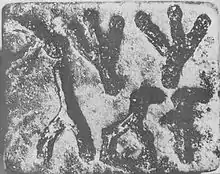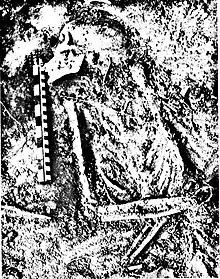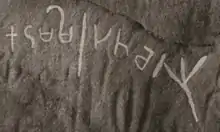Anaikoddai seal
Anaikoddai Seal is a steatite seal that was found in Anaikoddai, Sri Lanka during archeological excavations of a megalithic burial site by a team of researchers from the Jaffna University. The seal was originally part of a signet ring[1] and contains some of the oldest inscriptions in Tamil-Brahmi mixed with Megalithic Graffiti Symbols found on the island. It was dated paleographically to the early 3rd century BC.[1]



Although many pottery fragments have been found in excavations throughout Sri Lanka and Southern India that had both Brahmi and Megalithic Graffiti Symbols side by side, Anaikoddai seal is distinguished by having each written in a manner that indicates that the Megalithic Graffiti Symbols may be a translation of the Brahmi characters.
Read from right to left, the legend is read by most scholars in early Tamil as ‘Koveta’ (Ko-ve-ta 𑀓𑁄𑀯𑁂𑀢).[1][2][3][4][5][6] 'Ko' and 'Veta' both mean 'King' in Tamil and refers to a chieftain here. It is comparable to such names as Ko Ataṉ and Ko Putivira occurring in contemporary Tamil Brahmi inscriptions of ancient South India.[3][2] The trident symbol is equated with 'King', and is also found after a Tamil Brahmi inscription of the Chera dynasty, thus supporting this interpretation.[5]
Investigators disagree on whether Megalithic Graffiti Symbols found in South India and Sri Lanka constitute an ancient writing system that preceded the introduction and widespread acceptance of Brahmi variant scripts or non lithic symbols. The purpose of usage remains unclear.[7]
References
- Raghupathy 1987, pp. 199–204
- Mahadevan, I. (2014). Early Tamil Epigraphy - From the Earliest Times to the Sixth century C.E., 2nd Edition. pp. 44, 65.
- Indrapala, K. (2005). The Evolution of an Ethnic Identity - The Tamils of Sri Lanka 300 B.C.E to 1200 C.E. ISBN 0-646-42546-3. p. 324-325
- Frontline, Reading the past in a more inclusive way - Interview with Dr. Sudharshan Seneviratne. (2006) https://frontline.thehindu.com/other/article30208096.ece
- Bopearachchi, Osmund. Graffiti Marks of Kodumanal (India) and Ridiyagama (Sri Lanka) — A Comparative Study (2002) p. 100
- Seneviratne, Sudharshan. (1992). Pre-State Chieftains And Servants of the State: A Case Study of Parumaka. p. 108 http://dlib.pdn.ac.lk/handle/123456789/2078
- Boivin 2003, pp. 29–31
Cited literature
- Indrapala, Karthigesu (2007). The evolution of an ethnic identity: The Tamils in Sri Lanka C. 300 BCE to C. 1200 CE. Colombo: Vijitha Yapa. ISBN 978-955-1266-72-1.
- Raghupathy, Ponnambalam (1987). Early settlements in Jaffna, an archaeological survey. Madras: Raghupathy.
- Boivin, Nicole; Korisettar, Ravi; Venkatasubbaiah, P.C (2003), "Megalithic Markings in Context: graffiti marks on burial pots from Kudatini, Karnataka", South Asian Studies, 19 (1): 21–33, doi:10.1080/02666030.2003.9628618
